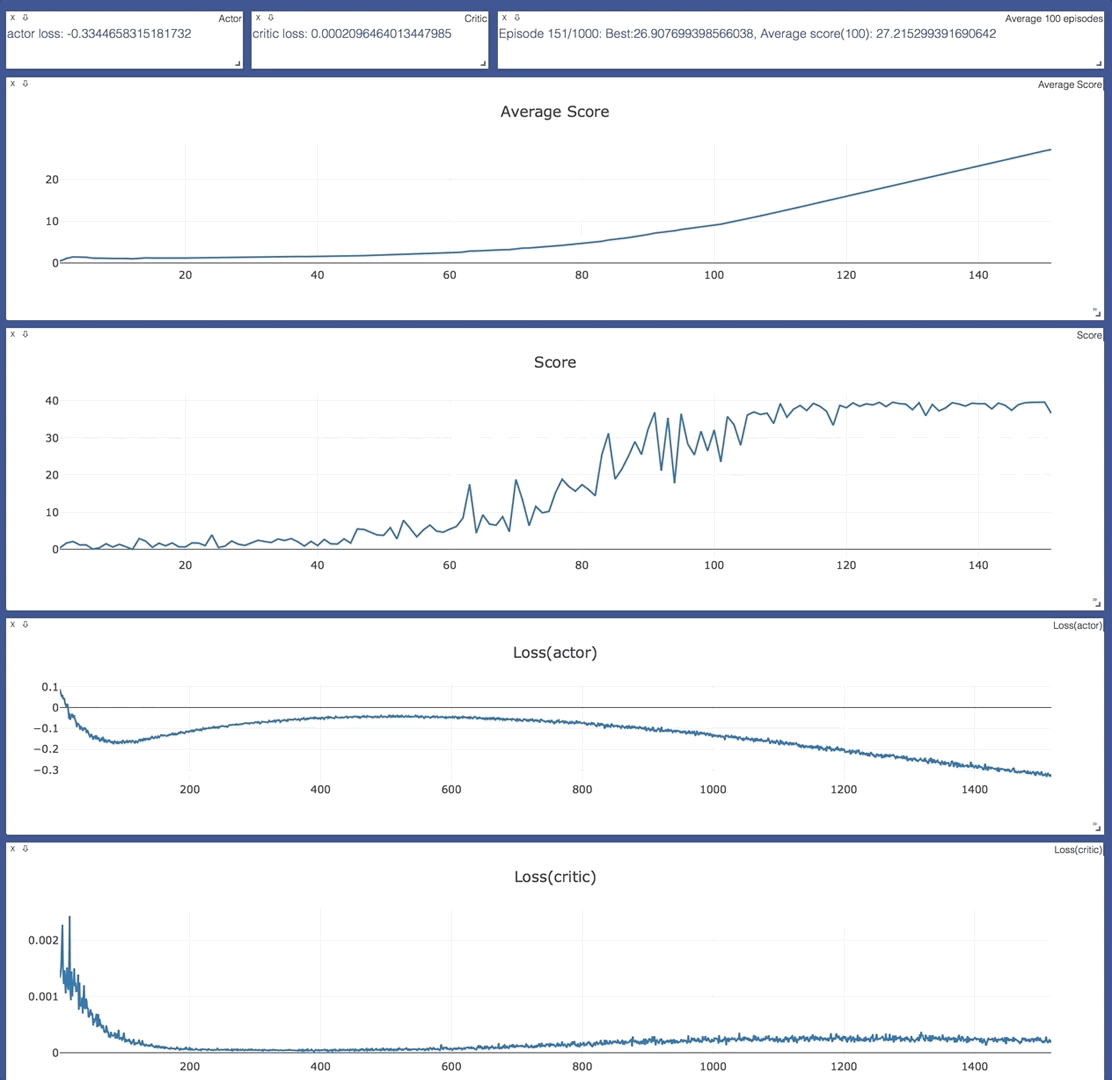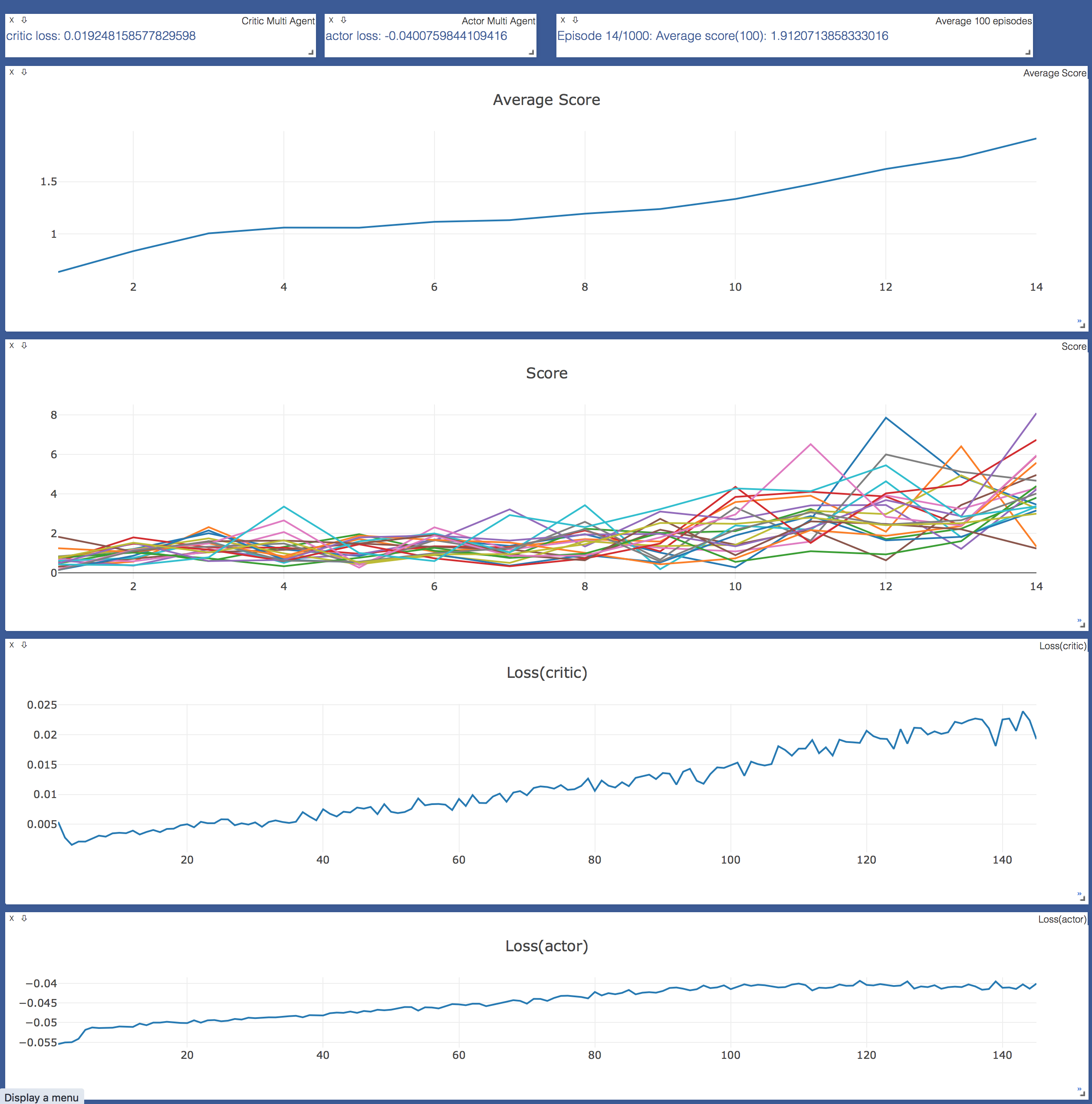In this project, we are challenged to solve Reacher environment.
The environment, a double-jointed arm can move to target locations. A reward of +0.1 is provided for each step that the agent's hand is in the goal location. Thus, the goal of your agent is to maintain its position at the target location for as many time steps as possible.
The observation space consists of 33 variables corresponding to position, rotation, velocity, and angular velocities of the arm. Each action is a vector with four numbers, corresponding to torque applicable to two joints. Every entry in the action vector should be a number between -1 and 1.
We use deep deterministic policy gradients (ddpg) to solve the environment using pytorch.
The task is episodic, and in order to solve the environment, the agent must get an average score of +30 over 100 consecutive episodes.
The barrier for solving the second version of the environment is slightly different, to take into account the presence of many agents. In particular, the agents must get an average score of +30 (over 100 consecutive episodes, and over all agents). Specifically,
- After each episode, we add up the rewards that each agent received (without discounting), to get a score for each agent. This yields 20 (potentially different) scores. We then take the average of these 20 scores.
- This yields an average score for each episode (where the average is over all 20 agents).
The environment is considered solved, when the average (over 100 episodes) of those average scores is at least +30.
-
Clone this repo
-
Download the environment from one of the links below. You need only select the environment that matches your operating system:
| Version | Binary |
|---|---|
| Version 1: One (1) Agent | LINUX, LINUX-NO-VIZ, MAC, WIN32 |
| Version 2: Twenty (20) Agents | LINUX,LINUX-NO-VIZ, MAC, WIN32, WIN64 |
(Use LINUX-NO-VIZ for training in headless mode)
-
Create a top level directory "env" and unzip the contents of the file inside env.
-
(Optional but recommended) create a conda environment
conda create -n myenv python=3.6
- Install dependencies
conda activate myenv
pip install .
- Install unity ml-agents using the instructions here.
In order to train your agent, first start visdom
conda activate myenv
visdom
Default command line arguments
conda activate myenv
cd src
python trainer.py --help
usage: multitrainer.py [-h] [--num_episodes NUM_EPISODES] [--max_t MAX_T]
[--vis VIS] [--model MODEL] [--info INFO]
[--stop_on_solve STOP_ON_SOLVE]
optional arguments:
-h, --help show this help message and exit
--num_episodes NUM_EPISODES
Total number of episodes to train (default: 1000)
--max_t MAX_T Max timestep in a single episode (default: 1000)
--vis VIS Whether to use visdom to visualise training (default:
True)
--model MODEL Model checkpoint path, use if you wish to continue
training from a checkpoint (default: None)
--info INFO Use this to attach notes to your runs (default: )
--stop_on_solve STOP_ON_SOLVE
Stop as soon as the environment is solved (default:
True)
Train a single agent environment, you'll need more steps per episode in single agent mode than multi agent.
conda activate myenv
cd src
python trainer.py
Open your web browser to view the realtime training plots @ http://127.0.0.1:8097
Every time you run the trainer, a new directory is created under src/runs with following contents:
- log file
- hyperparams.json : contains the configuration used
- actor_losses.txt (actor_losses_multi.txt for 20 agents env): contains the loss for actor
- critic_losses.txt (critic_losses_multi.txt for 20 agents env): contains the loss for critic
- scores.txt : contains the entire score history
- scores_full.txt: Also contains the entire history but above file is updated at every episode so if you terminate before completing all episodes, this file will not be generated.
- checkpoint_actor.pth: Best weights for actor model
- checkpoint_critic.pth: Best weights for critic model
Train multi agent environment.
conda activate myenv
cd src
python multitrainer.py --num_episodes 250 --max_t 20
Once you start training the agent, the realtime plots can be viewed at http://127.0.0.1:8097
To use uploaded model checkpoints, use player.py
conda activate myenv
cd src
python player.py --help
usage: player.py [-h] [--env ENV] [--model MODEL] [--agent AGENT]
optional arguments:
-h, --help show this help message and exit
--env ENV Full path of environment (default: None)
--model MODEL Model checkpoint path, use if you wish to continue training
from a checkpoint (default: None)
--agent AGENT Number of agents. Specify either 1 or 20 (default: None)
For example, to run mac environment with model checkpoints
python player.py --env env/Reacher20.app --model checkpoint/single --agent 1


